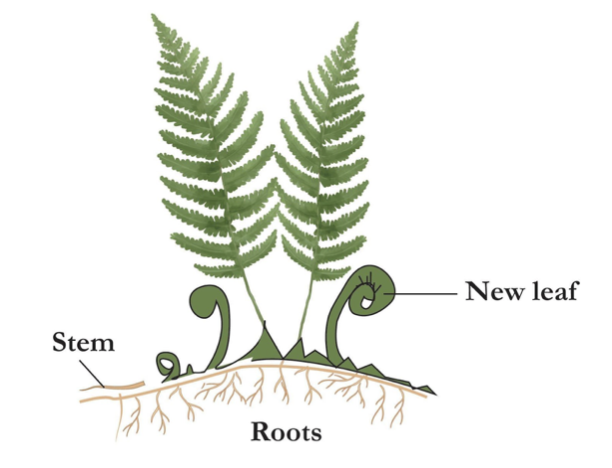
The plants with primitive vascular tissue are called
(a) Bryophytes
(b) Pteridophytes
(c) Angiosperms
(d) Gymnosperms
Answer
559.5k+ views
Hint: Ferns are typically well-differentiated, meaning they have well-developed roots, stems, and all but the spore dispersal happens when it comes to the life cycle, so it is known as the most primitive plant.
Complete answer:
Vascular cryptogams are also known as pteridophytes. They are seedless vascular plants with roots, stems, and leaves that are vascularized.
A vascular plant that disperses spores is a pteridophyte. Since neither flowers nor seeds are produced by pteridophytes, they are sometimes referred to as cryptogams, meaning that their means of reproduction are concealed. All the pteridophytes are ferns, horsetails, and lycophytes.

Vascular plants are characterized by botanists by certain key features, such as:
- Vascular plants have vascular tissues that through the plant distribute resources. In plants, two kinds of vascular tissue occur: xylem and phloem. Phloem and xylem are closely connected and are usually found in the plant directly adjacent to each other. As a vascular bundle, the combination of one xylem and one phloem strand adjacent to each other is known.
- The sporophyte, which produces spores and is diploid (having two sets of chromosomes per cell), is the main generation stage in vascular plants. In nonvascular plants, on the other hand, the main generation process is the gametophyte, which produces gametes and is haploid-with one set of chromosomes per cell.
Additional information: The first land-inhabiting or terrestrial plants are bryophytes. They are plants that are nonvascular, terrestrial, non-flowering, and non-seeded.
Gymnosperms are the seeded plants that are naked.
Angiosperms are vascular seed-bearing and flowering plants that have their seeds stored in fruits.
So, the correct answer is, ‘Pteridophytes’.
Note: The vast group of plants that live on the land are vascular plants, they are called tracheophytes, they have specialized tissue, which is xylem, it is lignified tissue for water and mineral conduction. And for the conduction of products produced during photosynthesis are non-lignified tissue.
Complete answer:
Vascular cryptogams are also known as pteridophytes. They are seedless vascular plants with roots, stems, and leaves that are vascularized.
A vascular plant that disperses spores is a pteridophyte. Since neither flowers nor seeds are produced by pteridophytes, they are sometimes referred to as cryptogams, meaning that their means of reproduction are concealed. All the pteridophytes are ferns, horsetails, and lycophytes.

Vascular plants are characterized by botanists by certain key features, such as:
- Vascular plants have vascular tissues that through the plant distribute resources. In plants, two kinds of vascular tissue occur: xylem and phloem. Phloem and xylem are closely connected and are usually found in the plant directly adjacent to each other. As a vascular bundle, the combination of one xylem and one phloem strand adjacent to each other is known.
- The sporophyte, which produces spores and is diploid (having two sets of chromosomes per cell), is the main generation stage in vascular plants. In nonvascular plants, on the other hand, the main generation process is the gametophyte, which produces gametes and is haploid-with one set of chromosomes per cell.
Additional information: The first land-inhabiting or terrestrial plants are bryophytes. They are plants that are nonvascular, terrestrial, non-flowering, and non-seeded.
Gymnosperms are the seeded plants that are naked.
Angiosperms are vascular seed-bearing and flowering plants that have their seeds stored in fruits.
So, the correct answer is, ‘Pteridophytes’.
Note: The vast group of plants that live on the land are vascular plants, they are called tracheophytes, they have specialized tissue, which is xylem, it is lignified tissue for water and mineral conduction. And for the conduction of products produced during photosynthesis are non-lignified tissue.
Recently Updated Pages
Master Class 12 Business Studies: Engaging Questions & Answers for Success

Master Class 12 Economics: Engaging Questions & Answers for Success

Master Class 12 English: Engaging Questions & Answers for Success

Master Class 12 Maths: Engaging Questions & Answers for Success

Master Class 12 Social Science: Engaging Questions & Answers for Success

Master Class 12 Chemistry: Engaging Questions & Answers for Success

Trending doubts
What is meant by exothermic and endothermic reactions class 11 chemistry CBSE

Which animal has three hearts class 11 biology CBSE

10 examples of friction in our daily life

One Metric ton is equal to kg A 10000 B 1000 C 100 class 11 physics CBSE

1 Quintal is equal to a 110 kg b 10 kg c 100kg d 1000 class 11 physics CBSE

Difference Between Prokaryotic Cells and Eukaryotic Cells




